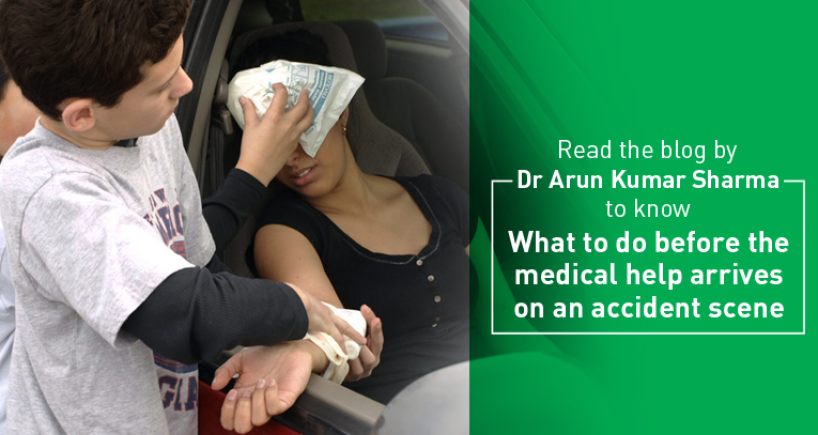
Witnessed An Accident? What To Do Before Medical Help Arrives

As per the WHO Global status report on road safety 2015, India is only second to China when it comes to the number of people who die in road accidents. Indian roads account for nearly 400 deaths a day, which equates to one precious life lost every 3.6 minutes. More than one person is killed every 24 to 36 hours in road traffic accidents in our tricity. Motorcyclists are particularly vulnerable, making up 34% of all traffic deaths. Most accident victims do not get proper medical attention and first aid on time. This leads to precious lives being lost.
The law commission of India observes that 50% of those killed in road accidents could be saved if timely assistance is rendered. A World Health Organization report claims that “skilled and empowered bystanders play a crucial role in saving lives” and “in order to enable bystanders to come forward and help injured persons, a supportive legal and ethical environment is needed”.
On March 30th 2016, Supreme Court of India approved guidelines for the examination of Good Samaritans by the police and during the trial. As per the guidelines, the disclosure of personal information by a Good Samaritan who brings an injured person to the hospital was made voluntary. It was also provided that the Good Samaritan would not be liable for any civil or criminal liability.
Given the fact that our legal system supports us, more precious lives can be saved by immediate action of the bystanders. The concept of ‘Golden hour’ emphasizes the urgency of care required by major trauma patients to prevent early deaths.
Most instant deaths in an accident result due to serious head injuries and profuse internal or external bleed. While we may not be able to do much in the above scenario, we can ensure first aid and guarantee safe transport of the surviving victim to the nearby hospital equipped to handle accident victims. The commonly observed injuries in an accident victim are fractures, bleeding, crush injuries and amputations. Always suspect serious injuries to head and neck when the victim is involved in a high-speed accident or has been thrown out of the vehicle.
The first advice for a witness of an accident is to remain calm and secure one’s own safety. Stay composed and call the highway patrol immediately. Carefully approach the scene of the accident and check the state of the victim. The second important rule is to do nothing to exacerbate the already existing injuries. Do not attempt to move an injured person unless they are in imminent danger. This includes fire and lying in the path of incoming traffic.
If the injured person needs to be moved, try to secure his/her head and neck by placing one hand on each side of the head before moving. Ensure there is no jolt or abnormal movement between the head and neck. As a rule of thumb, presume that the victim has undetected neck injuries if you find injuries or abrasions above the collarbone. We doctors frequently come across situations where the accident victim suffered minor injury to the neck, which turned life threatening due to inappropriate handling of the victim by the bystanders. The above precautions will also apply to an accident victim trapped inside a badly damaged vehicle. Do not give water or food to the victim if he/she appears to have altered sensorium as this could lead to choking.
The motorcycle crash victim may receive multiple injuries and could have an associated neck injury too. If the victim is unconscious and has a helmet covering his face, gently remove the wiser and the helmet strap. The helmet should be removed in an utmost gentle manner ensuring no abnormal movement of the neck. To remove the helmet it is best to have two people available, one person to steady the head and neck and the other to remove the helmet.
The victim should always be transported on a stretcher or a stiff board. The victim should be moved using a technique known as logroll (roll the person like a log of wood). This is important to reduce the amount of movement the person experiences to avoid his/her injuries getting worse. Always strap the injured person securely to the stretcher with the help of a rope or a clean cloth. If there is bleeding from the mouth or the patient is vomiting, turn the person to his/her side.
If there are extensive wounds and profuse bleeding, try to control the bleeding using pressure to the area using a cloth. Press with your palm on the area of bleed rather than above. Apply pressure bandage over the area of bleed with an available clean cloth. If you suspect that the victim may have suffered serious internal injuries try to transport him/her to the hospital at the earliest.
If a fracture is suspected, the limb should be stabilized with a splint to prevent abnormal movement of the fractured bone. Any abnormal movement of the fractured limb results in pain and risk of injury to blood vessels around it. If you come across a situation with an amputated limb, gently place the part in a plastic bag if feasible. Place the bag into a container or bucket of cold water. Ensure that the severed part is transferred to the hospital with the patient.
The worst-case situation is when a responsive victim suddenly looses consciousness and stops breathing. Death occurs within minutes if the victim does not receive immediate life saving treatment, popularly known as cardiopulmonary resuscitation (CPR).
If you do not hear or observe breaths and the victim is unresponsive, immediately shout for help and start cardio-pulmonary resuscitation. A single rescuer with limited training should focus on providing only high quality chest compressions. Compressions pump the blood in the heart to the vital organs of the body. A firm surface allows compressions of the chest and heart to create blood flow. The essential elements of a high quality CPR are - compressions at the rate of 100-120/min, compress the chest at least 5 cm, allow the chest to recoil completely and minimize interruptions in chest compressions. When help arrives, the resuscitation team may choose to continue CPR at the scene or transport the victim to an appropriate facility while continuing rescue efforts.
The initial care of a person who is critically injured is a challenging task, and every minute can make the difference between life and death. The next time you come across an accident victim be prepared to provide first aid and rush him to a nearest hospital. Follow the basic rules and contribute towards saving precious lives.








}}drupal-data/images/blog-lists.png)



